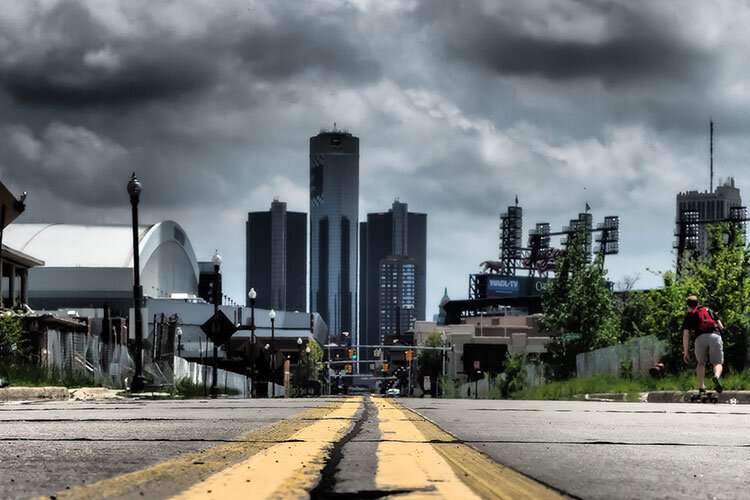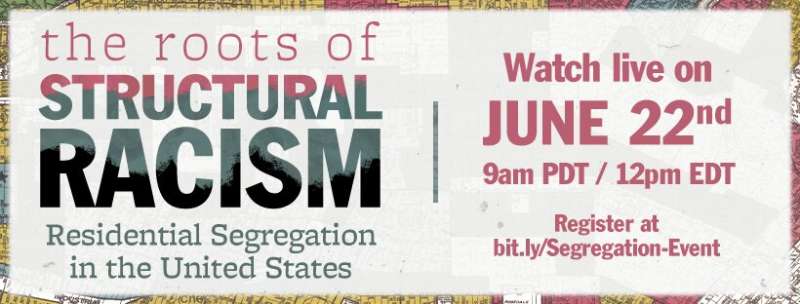How American racism is rooted in residential segregation

The disproportionate use of police brutality against people of color in America. Higher COVID-19 death rates of Black and Latinx people in the health care system. Lower percentages of homeownership and loans approved in Black communities. Society often labels these disparities as racism or prejudice against individuals with specific racial identities.
But new research from UC Berkeley's Othering and Belonging Institute shows that these inequities are symptoms of a much more racially systemic problem—residential segregation.
"It's the racial identity of the neighborhood you live in, and whether it is segregated or not, that really correlates with these negative outcomes," said Stephen Menendian, the institute's director of research. "And these outcomes have gotten worse over time. If you measure what the average neighborhood looks like for a particular racial group, you actually see that we are as segregated today as we were in 1940."
Released today, the report provides an annotated bibliography of local histories of segregation from 60 American cities and an interactive mapping tool that illustrates the level of segregation for every city, region and neighborhood.
The research found that 81% of metropolitan regions were more segregated in 2019 than in 1990. That lack of integration has led to a disproportionate distribution of resources in segregated communities of color compared to segregated white communities, said Menendian, and a neighborhood poverty rate three times higher in those communities of color.
According to the report, Black and Latinx children raised in integrated neighborhoods earn nearly $1,000 more annually as adults and $4,000 to $5,000 more when raised in white neighborhoods, compared to those raised in segregated communities of color. Moreover, household incomes and home values in white neighborhoods are twice as high as those in segregated communities of color.
On Tuesday, Menendian will delve deeper into the impact of residential segregation in America during a livestreamed forum with other leading race and housing scholars and advocates from across the country.
Menendian recently spoke with Berkeley News about the ways residential segregation has changed over time, and how a lack of integration has led to a "very sick" American society.
Berkeley News: Why are America's neighborhoods more segregated now than 30 years ago?
Menendian: We're more segregated today because we are more diverse, and our communities are highly balkanized across the spaces we occupy.
Even as we've desegregated workspaces, desegregated play areas, desegregated mainstream culture and, to some extent, we've desegregated schools, there are still racially identifiable neighborhoods in cities across the country. And it causes a lot of inequality.
But segregation actually looks a lot different today. While 20th century segregation was also residential—Black urban areas versus white suburban areas—in the 21st century we're seeing segregation as more regional today. We're also seeing white suburbs and Black suburbs.
A city like Ferguson, Missouri, in 1970 was 90% white. But by 2010, it's 66% Black. Segregation now is more mobile and more regional than it was in the 20th century. It's much more multiracial. It's not binary. And it's about the community you live in, not the neighborhood within the city you live in.
What hasn't changed is that these segregated communities of color are still poorly resourced. White communities have these high pockets of private wealth and resources, while non-white areas have very anemic low levels of wealth where residents are extremely underpaid, under-resourced, and have disinvested public goods and infrastructure.
What other racial disparities correlate with this lack of integration?
When you think about disproportional use of police brutality, or COVID-19 health outcomes and unemployment in communities of color, society often labels these disparities as racism in these individual institutions. But all these outcomes are really connected to residential segregation. This is what makes it systemic and not institutional racism.
For example, police are most brutal in either highly segregated Black communities, where they're targeting Black people. Or they are hyper-policing in neighborhoods that are white, so Black people driving through those white neighborhoods are more likely to be pulled over. Segregation is the force behind it all.

If you live in a neighborhood that has good jobs, access to a healthy environment, access to green spaces and good schools, all of those things aren't correlated with race, per se. It's correlated with racial segregation that still exists today.
It's not the individual race of the person. It's the race of the community that actually correlates these outcomes, and that's what our research shows.
White people living in highly segregated communities of color do just as bad, or almost as bad, as the people of color living in those neighborhoods. And people of color living in highly segregated white neighborhoods do much better than their counterparts in highly segregated communities of color.
It's really what we mean by structural racism. That is to say, structural racism is not about an individual that's being discriminated against. It's about the environment we live in, and the forces that shape our lives.
What we really find is that it's structural racism that is at the core, and the taproot of structural racism is racial residential segregation, because it is a mechanism that sorts people into different kinds of environments—high opportunity environments versus low opportunity environments.
I think there are some things that help. The American Rescue Plan is giving a lot of money to cities. But I don't think our public's ability to raise funds is even close to meeting the scale of need.
So, it doesn't seem to be getting any better. We're in a kind of dystopian future.
Are we at a moment of crisis at this point?
I think we've been in crisis since at least the late 1960s. The Kerner Commission warned us that we were creating two segregated societies that would continue to be unequal. What they predicted actually happened. And none of the recommendations the Kerner Commission provided came to be.
We did everything wrong.
We disinvested in our society. We pulled up the carpet, and we didn't integrate. While we did actually integrate some of the schools, by the 1990s, the federal courts were out of that business, and schools have been resegregating ever since.
Everything seems to me to be on the wrong track, and we've been on the wrong track for a long time. So, what we have are these eruptions, these symptoms—police brutality, health outcomes and so forth—and it's like if your body is sick, and you're getting boils all over your body. That's sort of what we've been through.
We're just very sick, and we've been sick for a while.
What can we do to turn things around?
Integrate and invest. We need to resurface the reality that racial segregation is really the core cause of racial inequality. You can't zero out racial inequality in a highly segregated society. You can't have balkanization and then have equality. It's totally antithetical.
What we seem to be doing is we tear down statues or rename buildings instead of doing what we need to do, which is to massively invest—in public goods, childcare, public transit, community colleges and so forth—for a more integrated future. I just don't see how we can break all these cycles when, if you're born poor and Black or Hispanic in the United States, there's a track for you that is very hard to break out of.
So, we shouldn't be focusing, in my opinion, on these symptoms as much as we should be focusing on the root causes of structural racism.
And I just think we spend way too much time talking about symbols and performative gestures. If we're really serious about getting rid of racial inequality, then we have to shift our focus. And so this report and discussion on Tuesday is a push in that direction.
More information: The Roots of Structural Racism: Twenty-First Century Racial Residential Segregation in the United States - belonging.berkeley.edu/roots-structural-racism
Provided by University of California - Berkeley


















